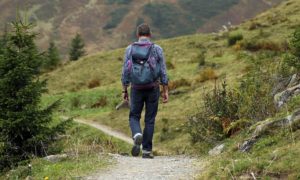Hiking alone or with your buddies can be a great and relaxing way to enjoy the great outdoors.
Yet, even with the best precautions through preparation and while moving about, injuries while on the trail are still a very common occurrence. How dangerous they are differs.
A simple cut, for instance, might not seem like it needs much attention and can be ignored, but there is the possibility that dangerous bacteria or viruses in an untamed environment might see this as an opportunity to invade your body and cause illnesses.
This article is here to examine common hiking injuries and what you should do if you experience any of them.
Blisters
A way too common annoying part of life, and an even more common occurrence while hiking.
In the case of hiking, blisters most commonly occur from the friction of your clothes and your skin or infections. Fluids collect in said parts of the skin, as they are irritated, making them swell and eventually tear if left untreated.
The best way to treat a blister? Rubbing the afflicted area with antibiotic ointment. Take care to not pop it as a blister does not heal faster whether or not it is popped, and you might instead expose the damaged area underneath to germs. The popped blister might also spread whatever microorganisms it had to other parts of your body or other nearby people.
Just keep it as is while the skin develops. You can also use blister-specific bandages to cushion the pain. Most blisters will go away on their own with no further treatment needed.
Twisted or Sprained Ankle
As hiking involves a lot of walking, it is no stranger to foot accidents while on the move. Rocky and uneven terrain are common culprits here, but hidden objects and slippery surfaces tend to cause this too.
Twisted ankles are not usually a cause for concern and can be “fixed” by taking a break. Make sure the afflicted ankle is on an elevated surface as well. (Trying to “walk if off” is not a good idea, especially if you do not know the severity of it yet)
However, on the occasion that your ankle can’t carry you much further, you might want to either call for help or ask your hiking partner to bring you back. Walking with a twisted or sprained ankle can be extremely dangerous and may lead to further complications should you insist on continuing onwards.
Poison Ivy
Who knew that an unassuming plant could turn you into an insane itching mess? Poison Ivy, Poison Oak, and Poison Sumac are notorious for being widespread and well hidden in forested environments. That leaf you just touched? It may very well be poison ivy, and you would have no way of knowing.
At least for a few hours. Then, you will suddenly feel a burning sensation all around the part that brushed that leaf. The poison ivy is finally taking effect, and it’s giving you a nasty rash. Don’t even try to scratch it, unless you want to spread the oil secretion of the poison ivy all around your body and give it even more rashes.
Thankfully, poison ivy is not fatal. It’s not actually truly “poisonous”. Still, it can leave you with really uncomfortable itches for days or even weeks to come.
If you know that you have come into contact with poison ivy recently, the best thing you can do is to rinse the afflicted area with a lot of soap and water or rubbing alcohol as soon as possible. The oils from the plant will not have dried yet at that point, giving you time to avoid the rashes entirely if you act fast.
On the other hand, if the rashes have already started appearing, you may want to consider heading back home, if you haven’t already. Being afflicted with poison ivy is an extremely uncomfortable experience, and while not fatal, can be very painful and itchy to deal with.
You can visit a doctor back home too, and while they won’t be able to prescribe a cure, they can at least prescribe treatment to soothe your rashes as much as possible while it runs its course.
Scrapes/Cuts
Scrapes and cuts are fairly common when threading forests, especially when traveling through thick trees or threading through uneven terrain.
Their danger range varies widely, as a cut with a bleeding wound can easily be nothing to worry about or turn out to have caught an extremely dangerous infection.
To prevent the worst-case scenario as much as possible, treat any and all scrapes and cuts with antibiotic lotion. Then cover them up with band-aids placed properly to ensure that the skin isn’t irritated while healing.
Keep an eye out on your skin as well as it heals, at least to ensure that the injured part of your body did not get infected by something.
Sunburn
Ouch! You’ve got an uncomfortable red tinted part of your skin, which really hurts to touch. Did you forget to wear proper clothing? Or maybe you forgot to apply sunscreen?
In any case, you still got an annoying sunburn, which is something you probably thought only happened to sunbathers in beaches and pools. It’s not serious but can still put a bit of a damper in your hiker mood.
To soothe that part of your skin, applying products that contain Aloe Vera might help you.
Wrapping Up
Most of the injuries mentioned here are simple and uncomfortable. With the right treatment, that will be all they will ever amount to, so make sure that you are always prepared for when a disaster strikes and an emergency occurs.

